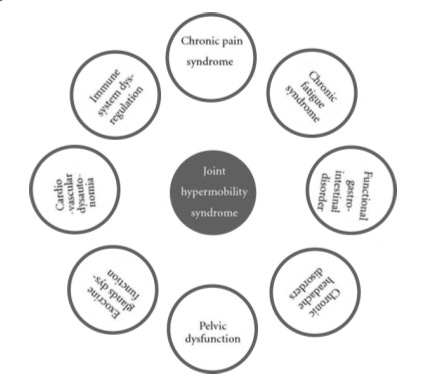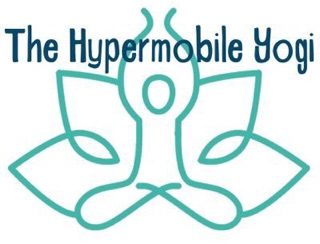The Hypermobile Yogi – Practicing Yoga with Joint Hypermobility Syndrome/EDS
Yoga International posted an article today called “Joint Hypermobility Syndrome: Yoga’s Enigmatic Epidemic?” (click on the article title to read the full article, or see link at the bottom of the page). For many hypermobile yogis, including myself, Yoga International’s article was a refreshing sigh of relief.
Finally! A factual article, stating the real genetic predisposition for joint hypermobility, and how it’s something that shouldn’t be glorified in yoga (or dance, or any other sport).
Additionally, the author mentions how she has approached practicing and teaching yoga safely – with appropriate modifications, as well as a ton of self-awareness. Most importantly, “Joint Hypermobility Syndrome: Yoga’s Enigmatic Epidemic?“ discusses how joint hypermobility is SO MUCH MORE than “just loose joints.”
The author also shares her personal yoga class experience, a bit about her own journey to a diagnosis of Joint Hypermobility Syndrome (JHS) (commonly known now as “Ehlers-Danlos syndrome – Hypermobility Type” or HEDS), as well as her yoga practice philosophy.
“Socially and politically I’m left of liberal. But on the mat, in part because of my excessive flexibility, I’m a die-hard conservative. You could say I’m kind of a fuddy-duddy. “How long did it take you to do that?” wistful students have asked over the years when I sit cross-legged with ease. For many of them, their hips are so tight that they can’t even imagine being comfortable in that position. “I’ve always been able to do this,” I tell them, not wanting to misrepresent yoga’s capabilities. I’m not boasting. My mobility is pathological.”
What is joint hypermobility or hypermobility syndrome, and why is it so much than “just loose joints?” (AKA – A very real, multi-systemic & chronic medical condition)

The difference between rotating too far and not
Several connective tissue disorders cause joint hypermobility. Ehlers-Danlos Syndrome is a “group of heritable connective tissue disorders that are caused by various defects in the collagen protein used to make our connective tissues. These disorders can cause a wide variety of complications throughout all body systems – Ehlers-Danlos Syndrome is very much a multi-systemic disorder. Based on recent research, the prevalence of EDS exceeds this number and could be as high as 1:100 to 1:200 people (Collins, 2015; Nielsen, 2013), or greater. Each type of EDS is characterized by a distinct problem in making or using one of the types of collagen. Collagen is the body’s most abundant protein and can be found in nearly every component of our bodies, from our ears, to our eyes and mouth, to our heart, surrounding our internal organs and veins, connecting our joints, in our bones and down to the tips of our toes. Collagen is a strong protein that provides both strength and elasticity to our tissues, as well as allows our tissues to be stretched safely without damage or without being stretched past a normal range. Ehlers-danlos Syndromes are structural problems caused by defects to the “glue” that holds our bodies together.”
Ehlers-Danlos Syndrome (EDS), and more specifically, Ehlers-Danlos Syndrome – Hypermobility Type (HEDS), are considered the most common causes of joint hypermobility. Some specialists who research and treat patients with EDS have come to the agreement and belief that Joint Hypermobility Syndrome and Ehlers-Danlos syndrome – Hypermobility Type, are one in the same condition; however, the jury is still out officially, and until we can genetically test every person with joint hypermobility, we will not know for sure. Though, I’m positive incredible strides will be made at the EDS 2016 International Symposium in May 2016.

Furthermore, Joint Hypermobility Syndrome/Ehlers-Danlos Syndrome – Hypermobility type and frustrations that so many its patients face, was explained in a paper published by Dr. Alan Pocinki, a physician well-known in the EDS community and who practices in the Washington, DC area, called ‘Joint Hypermobility and Joint Hypermobility syndrome’ – the same paper quoted in the Yoga International article.
“Experts estimate that up to 10% of the general population may have some degree of hypermobility, with women affected about three times more often than men. Most hypermobile people do not develop any problems from their loose joints, but some suffer chronic pain and other symptoms. Those who do suffer chronic joint pain and other symptoms related to their hypermobility or to the looseness of other tissues that often accompanies hypermobility have a condition called joint hypermobility syndrome (JHS).
Often, people who suffer from hypermobility syndrome are called hypo- chondriacs or lazy because they avoid many everyday activities, because these activities that cause them pain. Most of them don’t look sick and, as a result, friends, colleagues, and even doctors can be unsympathetic. Furthermore, they may spend years unsuccessfully searching for the cause of their chronic pain and other symptoms because many doctors are unfamiliar with hypermobility syndrome and its complex set of symptoms. Such long delays and lack of understanding can lead to frustration (with doctors and with daily life), anger, anxiety, and depression.”
To read the full post that was quoted above explaining what EDS is, go to: “What is Ehlers-Danlos Syndrome?”
Consequently, to practice yoga safely with hypermobility, you must be consciously conservative. What was once a “no-no” for those with EDS/HEDS/JHS, is proving to be quite the opposite. Taking classes with a yoga instructor who is also hypermobile, or who has knowledge in instructing the hypermobile yogi, such as the author of the post by Yoga Journal, can be instrumental in understanding how to not “go there” in certain positions.
”I am what I call a “tight, bendy person.” My joints are quite mobile—hypermobile—but my muscles are tight, with chronic knots. I’m careful when I practice yoga—with myself and with my yoga students—but am perpetually nursing one ache or another.”
Yes, yes and yes!!! It’s as if the hypermobile yoga Gods are finally coming together, to help those who are interested in yoga, but have not been not to practice it, and support all of us hypermobile yogis, who have been practicing yoga for many years (and with great success!)
The author goes on to explain in great detail how joint hypermobility is so much more than “just loose joints.” She also quotes Dr. Alan Pocinki in her article:
“In yoga class, those who have difficulty touching their toes may feel their lack of flexibility as a liability, and of course it can be. However, while inadequate range of motion isn’t optimal, it’s not nearly as perilous as excessive range of motion.
People with JHS often suffer from musculoskeletal and joint pain and soft tissue injuries like strains, sprains, tendonitis, and dislocations. Because our ligaments are unstable, we have an increased tendency to have scoliosis, TMJ, spinal disc problems, flat feet, and headaches. Dr. Alan Pocinki, an MD who practices in Washington D.C.’s metro area, and who has written what is in my opinion a groundbreaking article about JHS, explains: “Because…the ligaments [are]…too loose and therefore cannot do their job well, the muscles…are forced to do more of the work…than they are meant to do, so they become strained.”
To read Dr. Pocinki’s full article titled ‘Joint Hypermobility and Joint Hypermobility Syndrome’ click here.
If yoga has always been “easy” for you, learning more about Ehlers-Danlos syndrome – Hypermobility Type (HEDS)/Joint Hypermobility Syndrome (JHS) may be something to consider. As mentioned above, HEDS and JHS are regarded as one in the same condition, presenting with a broad spectrum of varying signs and symptoms. Make sure that the information you read is from a reputable source, such as the Ehlers-Danlos National Foundation (EDNF), EDS UK, or another well-known Hypermobility & EDS organizations. Strength/Flexibility/Health/EDS and EDS Wellness are great too!
A few more key points to remember:
– Several genetic connective tissue conditions cause joint hypermobility; Ehlers-Danlos Syndrome – Hypermobility Type (HEDS) is considered the most common cause of joint hypermobility.
– Hypermobility and flexibility are not one in the same; however, both terms are often used interchangeably.
– You do not have to be flexible to be hypermobile. In fact, there seems to be an equal number of those who have HEDS or another type of EDS, who are “stiff” and not so flexible. There’s even a type of EDS called, Ehlers-Danlos Syndrome – Musculocontractural type. EDS Musculocontractural type presents exactly as it sounds – a ton of muscle contractors or spasms. Quite the opposite of being flexible, yet the individuals who are affected are both stiff and hypermobile.
– You can also be flexible, but not hypermobile.
– There are several types of yoga, and all kinds of yoga practice can be modified.
– Finding the kind of yoga practice that works best for your body and your particular case of hypermobility syndrome/Ehlers-Danlos syndrome is critical. Doing so will ensure that you can learn how to practice yoga safely, increase joint strength and stability, as well as enjoy the countless mind/body benefits that so many hypermobile yogis enjoy.

To read more about Yoga & Hypermobility, as well as find resources on how to practice yoga safely, go to:
Interested in learning more about integrative approaches to living well with Ehlers-Danlos Syndrome and its comorbid conditions? If so, please visit: Strength/Flexibility/Health/EDS Additionally, if you like what you read and are interested in staying updated on posts related to practicing yoga safely with joint hypermobility, such as from Ehlers-Danlos syndrome (EDS) and related conditions, please subscribe here.
Questions? Feel free to send me an email: info@hypermobileyogi.com, or use the contact form at the bottom of this post.
Link to original article published by Yoga International: https://yogainternational.com/article/view/joint-hypermobility-syndrome-yogas-enigmatic-epidemic?utm_content=buffer4221f&utm_medium=social&utm_source=facebook.com&utm_campaign=buffer
This post was originally posted on Strength/Flexibility/Health/EDS; however, Strength/Flexibility/Health/EDS is currently being updated and prepared to relaunch as the first and ONLY digital wellness magazine for those living with Ehlers-Danlos syndrome, other hypermobility syndromes, and related conditions. ‘What is Ehlers-Danlos syndrome (EDS)?’ article reposted with permission of the original author.


